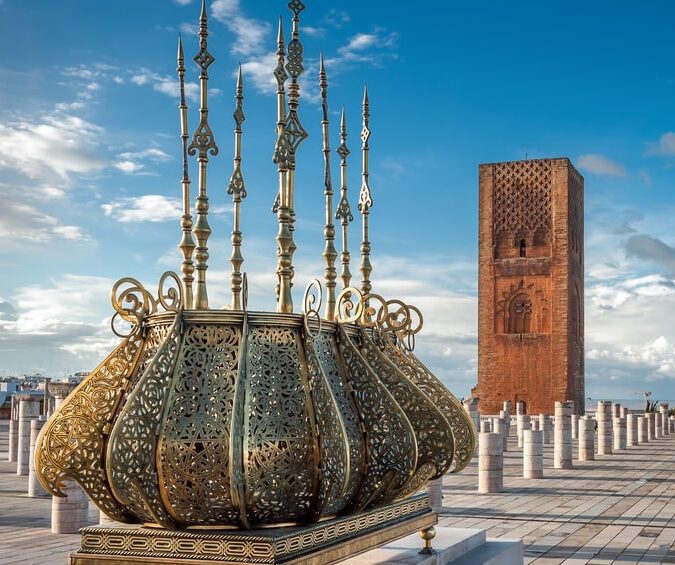Hassan Tower in Rabat :
Morocco has a rich cultural tradition, and historical monuments serve as a physical reminder of its past. One of the most iconic attractions in the country is the majestic Hassan Tower, an architectural marvel that has mesmerized tourists for decades. The capital city of Rabat is home to this unfinished minaret that offers a glimpse into the ambitious objectives and quest for grandeur of the Almohad Caliphate.
The Hassan Tower is remarkable for its magnificent design and imposing presence, making it a true masterpiece of Islamic architecture. In order to build the largest mosque in the Islamic world at the time, Sultan Yacoub al-Mansour gave the order for its construction in the later half of the 12th century. After the Sultan’s death, construction ceased, leaving the tower unfinished forever. It was supposed to be this luxurious mosque’s renowned minaret.
Even in its incomplete state, the Hassan Tower is a testament to the talent and expertise of Moroccan builders and artisans.The remaining portion of the tower, which reaches an astounding height of 44 meters (144 feet), features intricate carvings, artistic motifs, and exquisite calligraphy that accentuate the beauty of Almohad architecture.
One of the Hassan Tower’s most notable features is its ornate embellishments. The tower is adorned with exquisite carvings and geometric patterns that, in Islam, stand for unity and harmony. The intricate calligraphy and motifs that adorn the tower’s surface are a veritable masterclass in artistic expression. Expert craftspeople have painstakingly created every design.
The combination of these materials, along with the intricate carvings and embellishments, gives the tower its eternal beauty and UNESCO World Heritage Site designation.
The Fascinating History of Hassan Tower
To really appreciate the Hassan Tower, one must have a solid understanding of the intricate history that led to its creation. The Almohad Caliphate, a powerful Berber Muslim dynasty that ruled over parts of the Iberian Peninsula and North Africa in the late 12th and early 13th centuries, is when the tower’s history began.
As the aspiring and visionary leader of the Almohads, Sultan Yacoub al-Mansour sought to leave a lasting mark on the architectural landscape of his realm. In the later half of the 12th century, he gave the order to have the largest and most magnificent mosque in the Islamic world constructed in Rabat.
The project’s iconic minaret, the Hassan Tower, was supposed to stand tall over the city and symbolize the power and zeal of the Almohad Caliphate’s religion. In order to complete the Sultan’s vision, thousands of skilled artisans and laborers put in endless hours of work beginning in 1195.
That enormous undertaking, however, was never completed. Following Sultan Yacoub al-Mansour’s death in 1199, the construction of the great mosque and its iconic minaret, the Hassan Tower, came to an abrupt halt. Political turmoil, a lack of money, and the challenges of executing such a large-scale project are thought to have contributed to the project’s ultimate abandonment, even though the precise reasons for the stop remain unknown.
Even in its unfinished state, the Hassan Tower is a powerful symbol of the artistic and architectural achievements of the Almohad Caliphate. Its very existence is proof of the desire, skill, and dedication of the artisans and builders who devoted countless hours to producing this work of art.
A tangible reminder of Morocco’s rich Islamic history, the Hassan Tower also represents the enduring impact of the Almohad monarchy on modern society. Its unfinished state only adds to its charm, drawing visitors to marvel at the amazing craftsmanship that has withstood the test of time and to contemplate the grand ambition that remains unfulfilled.
Architectural Marvels of Hassan Tower
This incomplete minaret, with its imposing height and ornate carvings and decorative embellishments, is a testament to the artistic skill of the Almohad architects and artisans.
The 44-meter (144-foot) Hassan Tower is a towering structure that is likely to attract attention.Majesty and grace emanate from its unusual square base, which measures 16.5 meters (54 feet) on each side and tapers toward the summit. The tower’s walls, composed of a combination of sandstone and marble, are masterfully assembled with remarkable accuracy and structural stability.
One of the Hassan Tower’s most notable aspects is its ornate ornamentation. The tower’s surface is adorned with an incredible array of calligraphy, carvings, and decorative motifs that showcase the artistic talent of the Almohad painters. These intricate patterns, which are made with amazing attention to detail and place an emphasis on harmony, balance, and unity, are a reflection of Islamic art values.
Visitors are astounded by the tower’s finely carved geometric patterns, arabesques, and calligraphic inscriptions. These ornamental accents have theological and cultural significance in addition to being just decorative; they symbolize the intellectual and spiritual aspirations of the Almohad Caliphate.
The Hassan Tower is notable for both its amazing interior construction and its ornate exterior adornment. The tower’s interior is divided into multiple floors that are connected by a system of spiral staircases and tunnels. These interior spaces most likely had a variety of functions, such as providing access for maintenance or serving as venues for religious ceremonies and rites.
The Hassan Tower’s architecture displays the Almohad’s advanced understanding of engineering and construction techniques. The tower’s sturdy foundation and well planned slope ensure stability and structural integrity despite its enormous height and the passage of time.
All things considered, the Hassan Tower is a magnificent example of Islamic architecture that highlights the skill and talent of the Almohad artisans and builders. It is a testimony to Morocco’s rich cultural legacy and an iconic emblem of Rabat thanks to its exquisite design, expert craftsmanship, and timeless beauty.
Exploring the Surrounding Grounds
The surrounding gardens of this ancient site provide an equally intriguing view into the grandeur and ambition of the vision of the Almohad Caliphate, even though the Hassan Tower itself is unquestionably its focal point. Discover the half-built mosque, historical ruins, and lovely gardens here; each component enhances and contextualizes the experience in its whole.
You’ll discover the ruins of the partially built mosque—which at the time was supposed to be the largest in the Islamic world—as soon as you get closer to the Hassan Tower. Stretching across the grounds are the foundations and remnants of the mosque’s walls and columns, providing a palpable sense of the scope and size of the original design.
The partially finished building is a striking reminder of the Almohad rulers’ lofty goals and the difficulties they encountered in bringing their vision to life.
Well-kept gardens encircle the ruins and the Hassan Tower itself, giving the historic site a calm and beautiful backdrop. These verdant areas, embellished with fountains, palm trees, and well-kept pathways, provide a peaceful haven away from the bustle of the city.
There are several vantage points around the gardens that provide breathtaking views of the Hassan Tower and the surroundings as you meander through them. Photography aficionados can capture the tower’s magnificence from a variety of angles and perspectives by using these viewpoints.
The surrounding grounds have various smaller structures and places of interest in addition to the main attractions. The ruins of old defense walls, cisterns, and other architectural features are among them; they shed light on the elaborate engineering and planning that went into creating this historic site.
All things considered, exploring the surrounding area improves the Hassan Tower experience by giving guests a better grasp of the scope, aspirations, and background of this famous site. It’s an adventure that goes beyond the tower’s actual construction and invites guests to fully engage with Morocco’s rich architectural and cultural legacy.
Best Photo Spots at Hassan Tower
A photographer’s dream location, the Hassan Tower boasts stunning architecture and a gorgeous environment. This legendary site provides countless opportunity for breathtaking photos, regardless of your level of expertise as a photographer or your love for traveling and documenting experiences. Here are a some of the top locations for photos at the Hassan Tower so you can make the most of your trip:
- From the Gardens: The beautifully landscaped gardens surrounding the tower provide a serene and picturesque backdrop for your photos. Capture the tower rising majestically above the lush greenery, framed by palm trees and fountains. This angle also allows you to incorporate the partially completed mosque ruins into your shots, adding depth and historical context.
-
The Tower’s Base: Get up close and personal with the tower’s intricate carvings and decorative motifs by photographing it from its base. This angle allows you to showcase the tower’s impressive height while capturing the intricate details of its surface ornamentation, including geometric patterns, calligraphy, and arabesques.
- Framed by Archways: Explore the surrounding structures and look for archways or doorways that can frame the Hassan Tower in your shots. These architectural elements can add depth and a sense of scale to your photographs, creating visually striking compositions.
- Golden Hour and Sunset: Time your visit during the golden hour or around sunset to capture the tower bathed in warm, golden light. The soft, diffused light during these hours can create stunning contrasts and enhance the tower’s textures and details, resulting in breathtaking photographs.
- Panoramic Views: For a more expansive perspective, climb to a higher vantage point, such as a nearby rooftop or hill, and capture panoramic shots of the Hassan Tower and its surroundings. This angle can provide a sense of scale and showcase the tower in its urban context.
- Reflections: Look for opportunities to capture the tower’s reflection in nearby water features, such as fountains or small pools. These reflections can create unique and visually striking compositions, adding depth and interest to your photographs.
Always keep in mind to experiment with different angles and viewpoints, pay attention to lighting, and don’t forget to incorporate things that can provide a sense of scale and context when taking pictures of the Hassan Tower. The Hassan Tower presents an abundance of interesting and unforgettable photo options due to its magnificent architecture and rich historical background.
Visiting Hassan Tower: Essential Information
To guarantee a smooth and delightful vacation to Rabat, Morocco’s majestic Hassan Tower, it’s critical to be well-informed about the pertinent data. To assist you in getting ready for your visit, below is a thorough guide:
Hours of Operation and Admission Fees:
- The Hassan Tower is open to visitors daily, with varying hours depending on the season.
- Typical opening hours are from 8:30 AM to 6:00 PM, with last entry at 5:30 PM.
- Admission fees are quite reasonable, with discounted rates for students and children.
- It’s advisable to check the official website or with local tourism offices for the most up-to-date opening times and admission fees.
Recommended Visiting Duration and Best Times:
- Allocate at least 1-2 hours to fully explore the Hassan Tower, the surrounding grounds, and the partially completed mosque ruins.
- To avoid large crowds and enjoy a more serene experience, consider visiting early in the morning or late afternoon.
- Weekdays tend to be less crowded than weekends and holidays.
Accessibility for Visitors with Disabilities or Mobility Issues:
- The Hassan Tower and its surroundings are generally accessible for visitors with disabilities or mobility issues.
- Designated parking spaces are available close to the entrance.
- While the tower itself cannot be accessed internally, the surrounding grounds and gardens are wheelchair-friendly, with paved pathways and ramps.
- Assistance may be required for navigating certain areas, so it’s recommended to inquire about accessibility services or arrangements in advance.
Guided Tours and Audio Guides:
- To enhance your understanding and appreciation of the Hassan Tower’s history and architectural significance, consider joining a guided tour or renting an audio guide.
- Guided tours are often available in multiple languages and can provide valuable insights and context from knowledgeable local guides.
- Audio guides allow you to explore at your own pace while receiving detailed information about the tower and its surroundings.
Cultural Etiquette and Dress Code:
- As the Hassan Tower is a historic and culturally significant site, it’s important to dress respectfully and modestly.
- Avoid revealing clothing, and consider covering your shoulders and knees.
- Remove your shoes before entering any enclosed spaces or places of worship.
- Be mindful of local customs and traditions, and respect any signs or instructions regarding appropriate behavior.
Things to Do Near Hassan Tower in Rabat
Although the Hassan Tower is unquestionably Rabat’s main draw, the neighborhood has a plethora of interesting historical and cultural sites that are well worth seeing. To make the most of your trip to the Moroccan capital, try these must-do activities around the Hassan Tower:
- Mausoleum of Mohammed V: Just a short walk from the Hassan Tower stands the impressive Mausoleum of Mohammed V, a stunning example of Moroccan architectural craftsmanship. This grand mausoleum houses the tombs of the late King Mohammed V and his two sons, and its intricate decorations and beautiful gardens make it a must-visit attraction.
- Kasbah of the Udayas: Step back in time and explore the historic Kasbah of the Udayas, a fortified town dating back to the 12th century. Wander through its narrow streets, admire the traditional blue and white architecture, and visit the iconic Kasbah Mosque, which offers breathtaking views over the Bou Regreg River and the Atlantic Ocean.
-
Chellah Necropolis: Discover the remnants of an ancient Roman city at the Chellah Necropolis, a UNESCO World Heritage Site. This fascinating archaeological site features the ruins of a Roman town, a medieval mosque, and a lush garden oasis, providing a unique glimpse into Morocco’s rich history and cultural diversity.
- Explore Rabat’s Medina: Immerse yourself in the vibrant atmosphere of Rabat’s old town, or medina, where you can wander through a labyrinth of narrow streets, browse colorful markets, and experience the authentic flavors of Moroccan cuisine at local restaurants and cafes.
- Bou Regreg River Cruise: For a unique perspective of Rabat, consider taking a boat cruise along the Bou Regreg River. This leisurely journey offers stunning views of the city’s landmarks, including the Hassan Tower, from the water and provides an opportunity to learn about the river’s historical significance.
- Moroccan Culinary Experience: Indulge in the rich and flavorful cuisine of Morocco by joining a cooking class or food tour. Learn about the traditional spices and techniques used in Moroccan cooking, and savor the delicious flavors of dishes like tagine, couscous, and mint tea.
The region around the Hassan Tower offers a variety of activities and sights to enhance your trip experience, whether you’re an architecture aficionado, history buff, or just looking to get a taste of Morocco’s lively culture.



